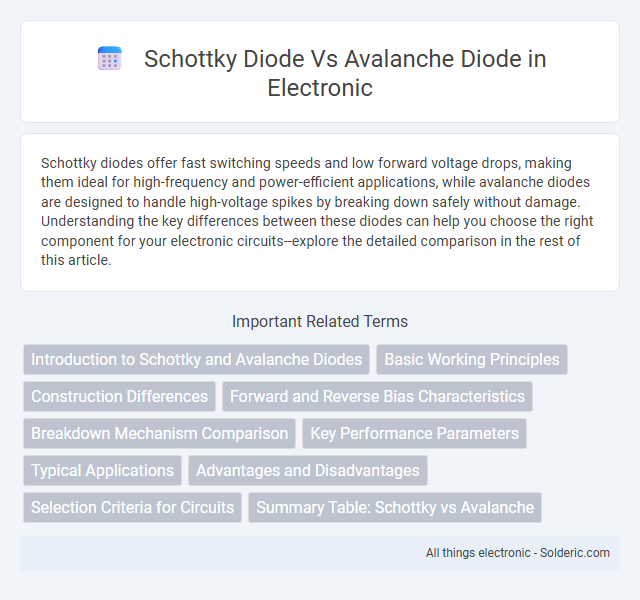Schottky diodes offer fast switching speeds and low forward voltage drops, making them ideal for high-frequency and power-efficient applications, while avalanche diodes are designed to handle high-voltage spikes by breaking down safely without damage. Understanding the key differences between these diodes can help you choose the right component for your electronic circuits--explore the detailed comparison in the rest of this article.
Comparison Table
| Feature | Schottky Diode | Avalanche Diode |
|---|---|---|
| Working Principle | Metal-semiconductor junction | Breakdown by avalanche multiplication |
| Forward Voltage Drop | 0.2 - 0.3 V (low) | Typically 0.7 V (silicon junction) |
| Reverse Recovery Time | Very fast (nanoseconds) | Slower, dependent on breakdown process |
| Reverse Voltage Rating | Low to moderate (up to ~100V) | High (up to several 100V or more) |
| Applications | High-speed switching, power rectifiers, RF mixers | Overvoltage protection, voltage regulation |
| Power Dissipation | Lower due to low forward voltage drop | Higher due to avalanche breakdown |
| Noise | Low noise | Higher noise during breakdown |
Introduction to Schottky and Avalanche Diodes
Schottky diodes feature a metal-semiconductor junction that enables low forward voltage drop and fast switching speeds, making them ideal for high-frequency and low-voltage applications. Avalanche diodes utilize the avalanche breakdown phenomenon to protect circuits by safely handling high voltage spikes through controlled breakdown without damage. Both diode types serve crucial roles in power electronics, with Schottky diodes optimized for efficiency and Avalanche diodes for voltage surge protection.
Basic Working Principles
Schottky diodes operate based on the metal-semiconductor junction that allows fast switching and low forward voltage drop, making them ideal for high-frequency applications. Avalanche diodes utilize the avalanche breakdown phenomenon where a high reverse voltage causes impact ionization, enabling controlled breakdown for voltage regulation and protection circuits. The key difference lies in Schottky's majority carrier conduction versus Avalanche diode's controlled avalanche multiplication under reverse bias.
Construction Differences
Schottky diodes feature a metal-semiconductor junction typically made from materials such as platinum or gold interfaced with n-type silicon, resulting in low forward voltage drop and fast switching speeds. Avalanche diodes have a p-n junction with a heavily doped depletion region designed to sustain avalanche breakdown without damage, enabling voltage regulation and protection in high-voltage circuits. The fundamental construction difference lies in Schottky's metal-semiconductor interface versus Avalanche's p-n junction optimized for controlled breakdown behavior.
Forward and Reverse Bias Characteristics
Schottky diodes exhibit low forward voltage drop, typically around 0.2 to 0.3 volts, allowing faster switching and higher efficiency in forward bias conditions compared to the 0.7 volts of avalanche diodes. In reverse bias, Schottky diodes have lower breakdown voltages and higher leakage currents, making them less suitable for high-voltage applications where avalanche diodes excel due to their ability to handle high reverse voltages and safely enter avalanche breakdown without damage. Understanding these forward and reverse bias characteristics helps optimize your circuit design for speed, efficiency, or voltage tolerance requirements.
Breakdown Mechanism Comparison
Schottky diodes utilize a metal-semiconductor junction that prevents a traditional avalanche breakdown by allowing majority carrier conduction, resulting in low forward voltage drop and fast switching speeds. Avalanche diodes rely on a p-n junction where breakdown occurs through impact ionization, generating a controlled avalanche current at a specific reverse voltage to protect circuits. Understanding the breakdown mechanism difference helps optimize your design for applications requiring either fast switching or voltage regulation.
Key Performance Parameters
Schottky diodes exhibit low forward voltage drop (typically 0.2 to 0.3 V), fast switching speed, and minimal reverse recovery time, making them ideal for high-frequency and low-loss applications. Avalanche diodes, on the other hand, are designed to handle high reverse voltage and offer reliable avalanche breakdown, characterized by a stable breakdown voltage and high surge current capability. Your choice between these diodes should consider factors like forward voltage, switching speed, breakdown voltage, and application-specific stress conditions.
Typical Applications
Schottky diodes are widely used in high-speed switching applications, power rectification, and voltage clamping due to their low forward voltage drop and fast recovery time. Avalanche diodes are primarily employed in over-voltage protection circuits, transient voltage suppression, and avalanche breakdown voltage regulation. Both devices serve critical roles in power management and signal integrity within electronics design, with Schottky diodes favored for efficiency and avalanche diodes critical for reliability in high-voltage environments.
Advantages and Disadvantages
Schottky diodes offer low forward voltage drop and fast switching speed, making them ideal for high-frequency applications and power efficiency; however, they have lower reverse voltage ratings and higher leakage currents compared to avalanche diodes. Avalanche diodes excel in high reverse voltage environments due to their ability to handle avalanche breakdown without damage, providing robust surge protection, but they exhibit slower switching speeds and higher forward voltage drops. When selecting your diode, consider the trade-off between speed and voltage tolerance based on your circuit's specific performance and reliability requirements.
Selection Criteria for Circuits
Schottky diodes are ideal for circuits requiring fast switching speeds and low forward voltage drop, making them suitable for high-frequency applications and power rectification where efficiency is critical. Avalanche diodes excel in protection circuits due to their ability to handle high reverse voltage and safely clamp voltage spikes, making them essential in surge suppression and voltage regulation. Your choice depends on whether the circuit prioritizes speed and efficiency with Schottky or voltage tolerance and protection with avalanche diodes.
Summary Table: Schottky vs Avalanche
A Schottky diode features low forward voltage drop (typically 0.2 to 0.3 V) and fast switching speed, making it ideal for high-frequency applications and low power rectification. An Avalanche diode is designed to handle breakdown voltage safely, with higher reverse voltage tolerance (often 50 V or more) and is used for overvoltage protection and voltage clamping. The summary table highlights key parameters: Schottky diodes excel in low forward voltage and switching speed, while Avalanche diodes provide robust avalanche breakdown capability and high voltage endurance.
Schottky diode vs Avalanche diode Infographic

 solderic.com
solderic.com